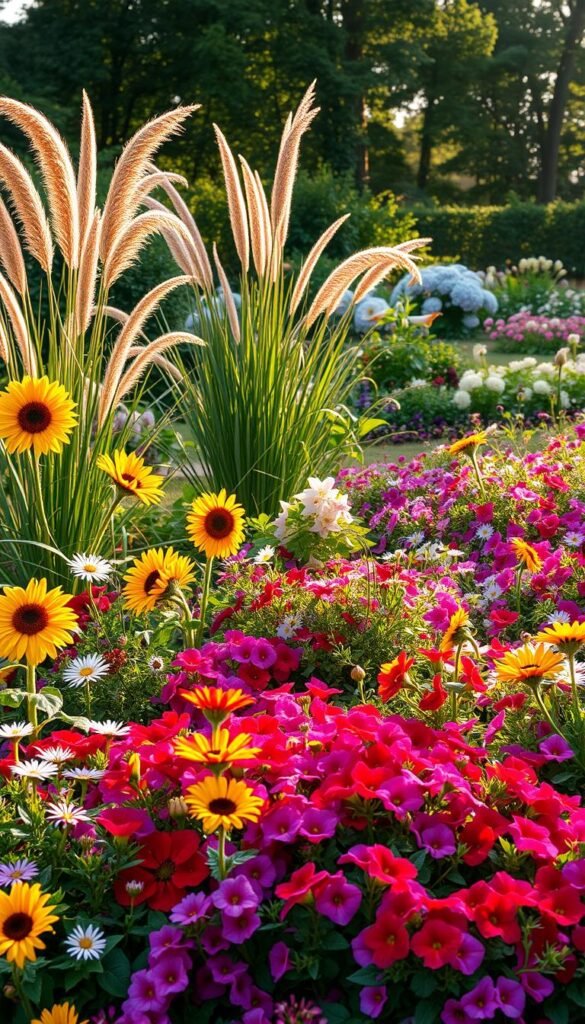Transforming your outdoor area into a lively retreat starts with understanding plant partnerships. Plants that return yearly offer reliable structure, while seasonal varieties deliver bursts of color that last for months. This balanced approach ensures your space stays dynamic from spring’s first buds to autumn’s final blooms.
Imagine clusters of white roses framing fiery canna lilies, or purple bellflowers dancing beside zinnias in sunset hues. These combinations work because they blend long-term performers with temporary showstoppers. The result? A living canvas that evolves through the seasons without losing its charm.
Strategic pairings solve common frustrations like patchy color gaps or underwhelming layouts. You’ll learn how to layer heights, textures, and bloom times for maximum impact. We’ll simplify design principles so you can craft eye-catching arrangements, whether you’re refreshing a small corner or reimagining larger areas.
Ready to create something extraordinary? Our guide breaks down everything from soil prep to color theory. You’ll discover how to balance bold annuals with dependable perennials – the secret to gardens that thrill neighbors and support local pollinators alike.
Understanding Your Garden’s Unique Needs
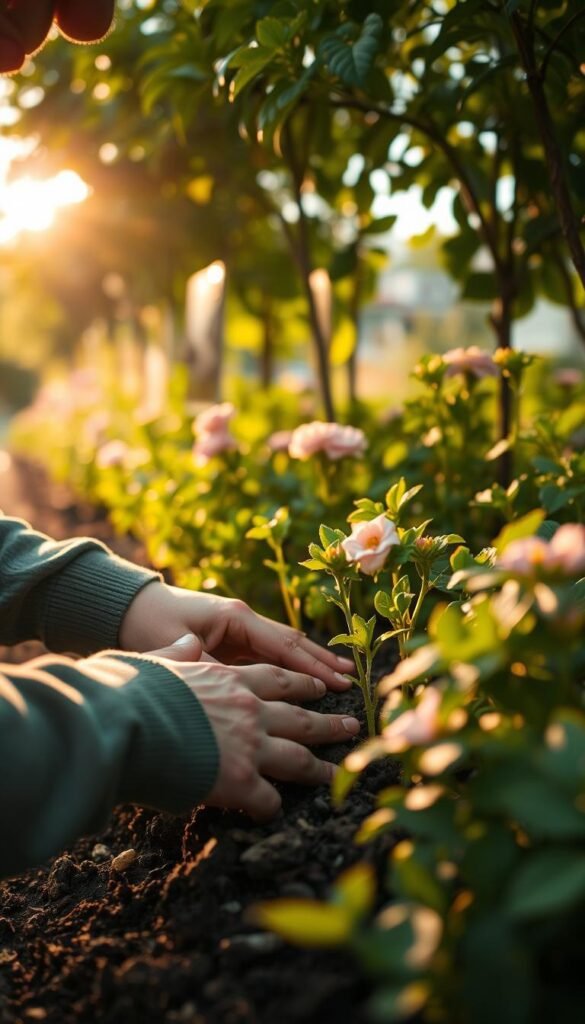
Successful plant growth hinges on matching nature’s blueprint. Your outdoor space has specific requirements that determine which greenery thrives. Let’s decode those needs so your efforts yield vibrant results.
Assessing Soil, Sunlight, and Water Conditions
Start by digging into your soil’s story. Turn over the top 6 inches and mix in compost – this boosts drainage and nutrients. Use a simple pH test kit to make sure your ground isn’t too acidic or alkaline for your chosen plants.
Track sunlight patterns for 3 days. Note where shadows fall and for how long. This reveals prime spots for sun-loving varieties versus those needing partial shade. Pair these insights with your local climate data – frost dates and rainfall averages matter more than you think!
| Plant Type | Sun Needs | Water Frequency | Soil Preference |
|---|---|---|---|
| Native shrubs | 4-6 hours | Weekly | Loamy |
| Colorful annuals | Full sun | Every 2-3 days | Well-drained |
| Drought-tolerant perennials | 6+ hours | Biweekly | Sandy |
Setting Personal Garden Goals
Ask yourself: What’s this space really for? A butterfly sanctuary? Evening entertaining? Low-maintenance beauty? Your answers shape everything from planting choices to irrigation setups. Balance dreamy visuals with practical care – maybe skip high-maintenance roses if weekends get busy.
Create a simple maintenance calendar. Factor in seasonal tasks like mulching or dividing perennials. Remember: A sustainable garden aligns with your lifestyle while respecting local ecosystems.
Backyard Flower Garden Ideas Landscaping: Mixing Perennials and Annuals
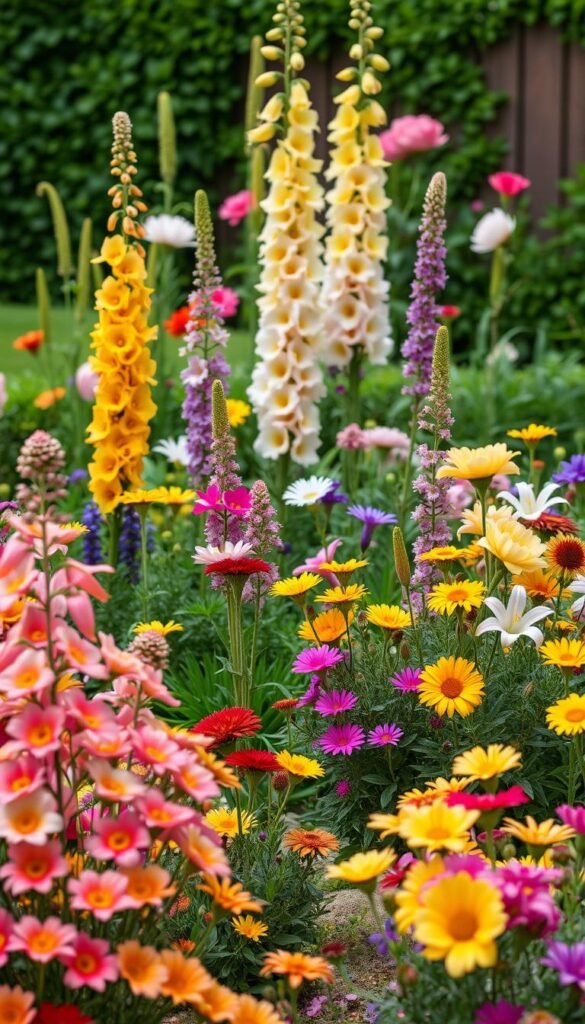
The secret to a dynamic display lies in balancing plants that stay with those that change. Picture a living tapestry where sturdy performers anchor your design while seasonal stars keep things fresh. This approach lets you build depth over time while enjoying instant gratification.
Why This Power Pair Works
Reliable performers like lavender or daylilies form your garden’s foundation. They return bigger each season, saving you money long-term. Meanwhile, petunias or marigolds deliver instant impact, letting you test bold colors without commitment.
Here’s the magic formula:
- Cluster 3-5 perennial plants as focal points
- Edge with annuals that bloom 10+ weeks
- Rotate seasonal varieties to refresh tired areas
Crafting Continuous Color
Smart timing turns good beds into great ones. Pair early-blooming peonies with summer snapdragons, then add autumn pansies. This table shows how to stagger plants:
| Season | Perennial Pick | Annual Partner |
|---|---|---|
| Spring | Bleeding Heart | Violas |
| Summer | Black-Eyed Susan | Zinnias |
| Fall | Sedum | Ornamental Kale |
Pro tip: Place taller specimens toward the back of your flower bed. This creates depth while letting sunlight reach shorter plants. You’ll enjoy evolving beauty that never looks sparse!
Designing a Layered Flower Bed for Depth and Color
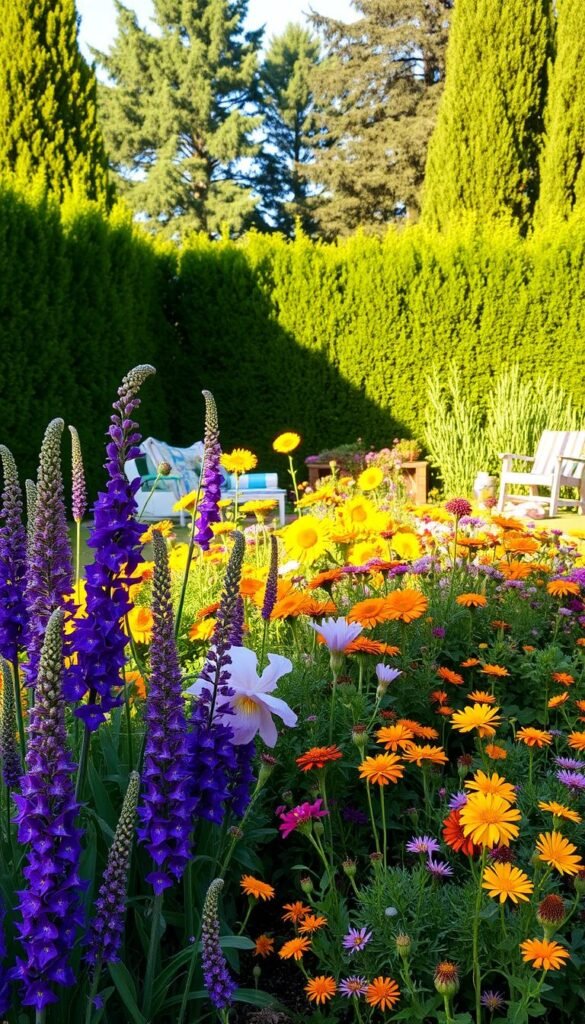
Transform flat spaces into vibrant canvases with height-based planting. Imagine your flower bed as a living staircase – each tier plays a crucial role in building visual interest. This approach turns basic arrangements into professional-looking displays that captivate throughout the seasons.
Start with structural anchors at the back. Tall varieties like foxglove or switchgrass create a lush backdrop. These vertical elements frame your space while sheltering shorter plants from wind. For middle layers, try bushy coneflowers or clustered dahlias – their medium height bridges gaps between tiers seamlessly.
Front-row performers need careful selection. Low-growing sedum or alyssum define edges while hiding bare soil. Pair these with seasonal annuals like pansies for quick color pops. Remember: varying leaf textures (feathery ferns next to broad hostas) add depth even when blooms fade.
Seasonal planning keeps your display lively year-round. Early spring bulbs push through winter mulch, while summer phlox takes center stage. Come fall, ornamental kale adds frost-resistant drama. This rotation ensures your flower bed never loses its look of abundance.
Color strategies elevate your design further. Warm tones (reds, oranges) advance visually, perfect for focal points. Cool hues (blues, purples) recede, creating illusion of depth. For inspiration on balancing shades, explore our guide to elevating your space through intentional color choices.
Pollinator-Friendly Flower Beds for Attracting Vibrant Wildlife
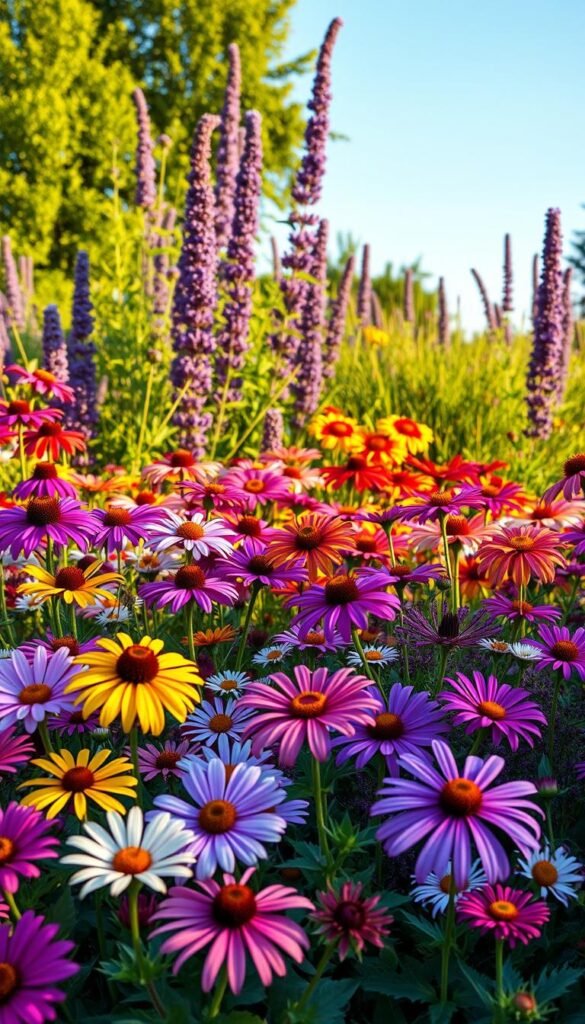
Create a buzz in your yard by welcoming nature’s hardest workers. Thoughtful plant selection transforms your space into a thriving habitat while adding lively color. Let’s explore how to design beds that nourish pollinators and delight the senses.
Choosing Plants That Invite Bees and Butterflies
Start with native species adapted to your region. These plants evolved alongside local wildlife, offering ideal food sources. For example:
- Early bloomers like columbine fuel hummingbirds during spring migrations
- Summer-blooming salvia becomes a hummingbird magnet
- Asters and goldenrod provide late-season fuel for monarch butterflies
This table shows seasonal stars for continuous feeding:
| Season | Plant | Attracts |
|---|---|---|
| Spring | Columbine | Hummingbirds |
| Summer | Coreopsis | Bees & Butterflies |
| Fall | New England Aster | Migrating Monarchs |
Add simple habitat features like shallow water dishes with stones for perching. Avoid pesticides – even organic ones can disrupt delicate ecosystems. For beginners, easy-to-grow flowers like zinnias offer instant impact with minimal effort.
Remember: diversity is key. Cluster similar flowers together so pollinators can efficiently gather nectar. Your vibrant oasis will soon host winged visitors while boosting nearby fruit and vegetable yields!
Modern Edging Techniques for a Crisp, Defined Look
A sharp border transforms your flower bed from messy to magazine-worthy. Think of edging as picture framing for your plants – it highlights their beauty while keeping your space organized. Whether you prefer natural curves or geometric precision, these methods ensure your greenery stays contained and eye-catching.
Material choice sets the tone for your entire look. For rustic charm, try irregular flagstones nestled at soil level. Modern metal strips create sleek lines that pop against mulch. Budget-friendly options like plastic barriers work wonders when hidden beneath soil and decorative gravel.
| Material | Best For | Installation Time | Durability |
|---|---|---|---|
| Brick | Traditional yards | 2-4 hours | 10+ years |
| Corten Steel | Contemporary spaces | 1-2 hours | 15+ years |
| Recycled Rubber | Curved designs | 30 minutes | 5-7 years |
Natural edges offer flexibility without materials. Use a half-moon edger to carve clean lines between grass and soil. Maintain the divide by trimming roots annually – this prevents creeping grasses from invading your flower bed.
Strategic planting enhances definition. Line borders with compact varieties like dwarf boxwood or colorful annuals in containers. This living edge softens transitions while maintaining structure.
Regular upkeep keeps edges crisp. Re-cut lines every spring and refresh mulch layers. Proper edging reduces weeding time by 40% – your yard stays neat with minimal effort. Now that’s smart gardening!
Tree Base Flower Beds: Enhancing Natural Elements
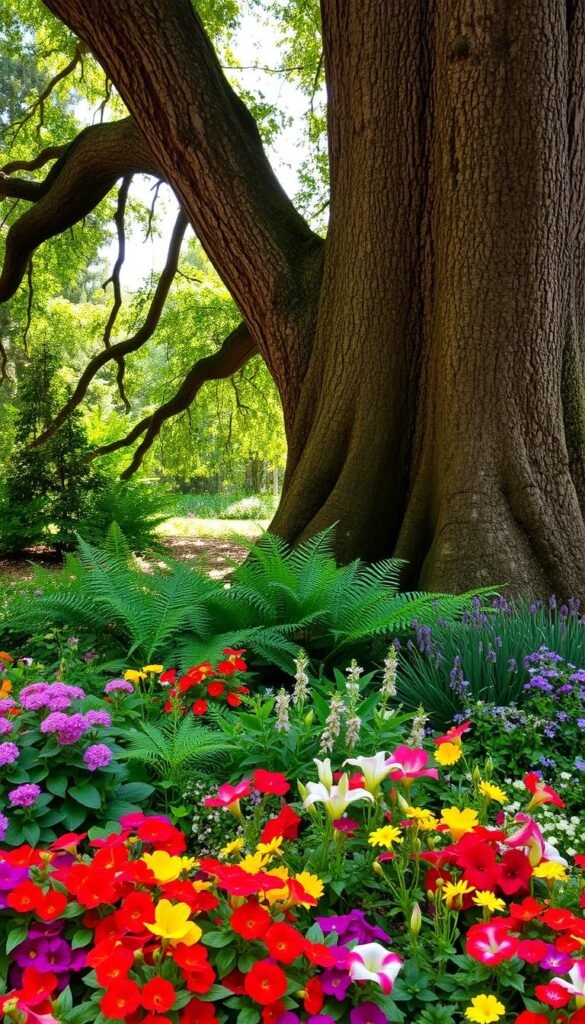
Turn tree bases into blooming masterpieces with these simple tips. That shaded area beneath branches often gets overlooked, but it’s prime real estate for creative planting. You’ll transform bare ground into lush displays that make your yard feel intentional and polished.
Start by choosing plants that thrive in dappled light. Hostas and coral bells add texture, while impatiens bring vibrant color without overwhelming the space. Always dig carefully to avoid damaging surface roots – use hand tools and limit soil depth to 3 inches.
| Tree Type | Recommended Plants | Special Considerations |
|---|---|---|
| Maple | Ferns, Astilbe | Acidic soil lovers |
| Oak | Heuchera, Lamium | Drought-tolerant varieties |
| Pine | Hellebores, Cyclamen | Needle-resistant groundcovers |
Got an old tree stump? Turn it into a planter by hollowing out the center. Fill it with soil and trailing lobelia for a fairy-tale effect. Fallen logs make perfect natural containers – just line them with landscape fabric before adding begonias or violas.
Water smartly by directing moisture to plant roots, not the tree trunk. A soaker hose coiled around the base ensures both greenery and your tree stay hydrated. Refresh mulch annually to suppress weeds and maintain consistent soil moisture.
These flower bed solutions create depth while respecting your landscape’s natural architecture. You’ll gain eye-catching layers that flow seamlessly from trunk to turf, proving even shaded spots can burst with life.
Revitalizing Overlooked Spaces: Side Yard Flower Beds
That slim corridor between house and fence holds untapped potential. While you’ve likely focused on your front yard and primary outdoor area, these narrow zones can become stunning transitional spaces. With smart design, your side yard transforms from forgotten passageway to botanical showcase.
Start by mapping sunlight patterns and soil moisture. Many side spaces battle shade from structures or competing root systems. Opt for compact hydrangeas in dim corners and drought-resistant perennials near sun-drenched walls. This tailored approach ensures thriving greenery without constant upkeep.
Narrow layouts demand clever solutions:
- Install vertical trellises with climbing roses to draw eyes upward
- Use alternating bloom colors to create depth illusions
- Edge pathways with low-growing thyme for fragrance underfoot
| Challenge | Plant Solution | Design Fix |
|---|---|---|
| Poor drainage | Swamp milkweed | Gradual slope with river rocks |
| Limited width | Columnar evergreens | Mirrored planters on walls |
| Utility eyesores | Tall ornamental grasses | Decorative screen panels |
Connect these zones to your main landscape by repeating key colors or textures. A cluster of purple salvias in your side flower bed might echo larger plantings elsewhere. For tight spaces, consider functional container arrangements that simplify watering and rearranging.
Transform awkward gaps into intentional destinations. A bench nestled among fragrant lavender turns a pass-through area into a secret retreat. With thoughtful planning, your side yard becomes proof that no space is too small for beauty.
Vertical and Raised Beds: Maximizing Your Outdoor Space
Unlock hidden potential in your yard by reaching upward, not outward. Vertical and raised beds solve common challenges like limited ground space or poor soil quality. These smart systems let you grow more in tighter areas while adding architectural interest to your layout.
Space-Saving Design Tips
Start with modular setups that adapt as your needs change. A 4×6-foot raised bed offers easy access from all sides while fitting snugly against fences or walls. Try square-foot planting – one section could hold 16 carrots or 9 spinach plants. Trellises on the north side support climbing veggies without shading shorter plants.
Multi-Level Planting Techniques
Layer plants by height to create living walls of greenery. Place tall sunflowers or pole beans at the back, mid-height herbs in the center, and trailing nasturtiums along the edges. For small patios, stack planter boxes with drainage holes between tiers. Our step-by-step guide shows how to build sturdy elevated beds that triple your growing area.
Mix textures and colors across levels for visual drama. Silver thyme spills over cedar edges while purple kale reaches skyward. These solutions prove even compact spaces can burst with life when you think vertically!

